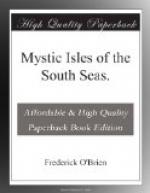“One must wake him up,” said Tetuanui. “He is asleep most of the time.”
I wrote him a letter, and on the day appointed, Tatini and I, barefooted, started. We went through Tetuanui’s breadfruit-grove, and there, as wherever were choice growths, I stopped to examine and admire. No other tree except the cocoa equals the maori in usefulness and beauty. The cocoa will grow almost in the sea and in any soil, but the breadfruit demands humus and a slight attention. The cocoas flourish on hundreds of atolls where man never sees them, but the maoris ask a clearing of the jungle about their feet. The timber of the breadfruit is excellent for canoes and for lumber, and its leaves, thick and glossy, and eighteen inches long by a foot broad, are of account for many purposes, including thatch and plates. There are half a hundred varieties, and each tree furnishes three or four crops a year, hundreds of fruits as big and round as plum-puddings, green or yellow on the tree, pitted regularly like a golf-ball, in lozenge-shaped patterns. The bark of the young branches was used for making a tough tapa, native cloth, and resin furnishes a glue for calking watercraft. The tree bears in the second or third year, is hardy, but yields its life to a fungus, for which there is no remedy except, according to the natives, a lovely lily that grows in the forest. Transplanted, at the roots of the maori, the lily heals its disease and drives away the parasite. The missionaries cited this as a parable of Christianity, which would save from damnation the convert no matter how fungusy he was with sin. In tribal wars the enemy laid a sea-slug at the heart of the maori, and, its foe unseen, the tree perished from the corruption of the hideous trepang.
Papeari, the next district west of Mataiea, was well watered, as its name signified, and we passed cows and sheep and horses grazing under the trees or in pastures of lush grass. Swamps had been ditched and drained, and there was evidence of unusual energy in agriculture. The country gained in tropical aspect as we approached the narrow strip of land which is the nexus of Tahiti-nui and Tahiti-iti, of the blade and the handle of the fan. Tahitian mythology does not agree with geology, any more than does the catechism; for though the scientists aver that these separate isles were not united until ages after their formation, a legend ran that at one time the union was complete, but that a sea-god conceived a hatred for the inhabitants of the Presqu’ile of Taiarapu, the fearless clans of the Teva-i-tai and the Te-Ahupo.
One very dark night when the moon was in the ocean cavern of this evil Atua, he began his horrid labors to sever the tie. He smote the rocks from the foundations, and the people heard in terror throughout the night the thunders of his blows. He had almost achieved his task when the goodly sun-god appeared over the mountains far in advance of his usual time, and blinded the Titan so that he sought safety beneath




